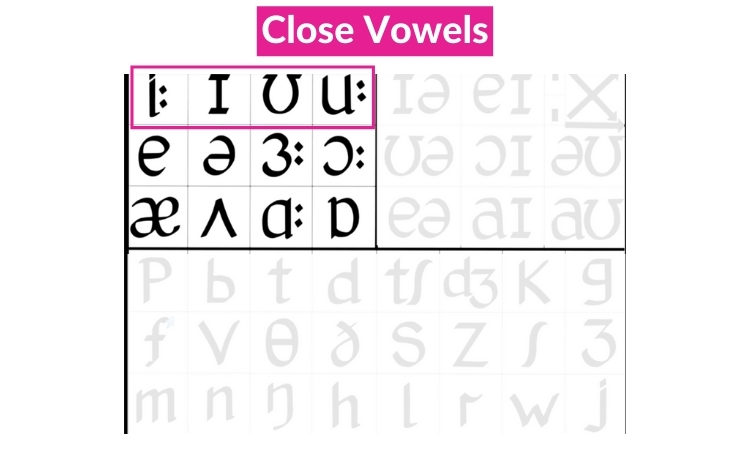Master the Pronunciation Theory & Practice and Become Comfortable Teaching it!
Close Vowels


For close vowels the tongue is quite high in the mouth.
Moving from /iː/ through to /uː/, we also notice the different positions of the tongue;
/iː/ is a front vowel, and
/u:/ is a back vowel.
If we move from /i:/ to /u:/ we can also notice the movement of our lips.
For /i:/
Lips go back (spread lips as when smiling) and the tongue goes forward.
For /u:/
Lips go forward (round lips) and the tongue goes back.
In English, when lips go forward the tongue goes back, and when lips go back the tongue goes forward. This principle is not true for all Languages. (eg French and Scandinavian Languages)
While moving from/i:/ to /u:/ we produce a series of other in-between sounds. /ɪ/ and /ʊ/ are some of these sounds.
For /ɪ/
The tongue is not as forward and high as for /i:/. Tongue, lips, and cheeks are more relaxed. The sound /ɪ/ is short.
For /ʊ/
the tongue is not as back and high as for /u:/ and the lips are not fully rounded as for /u:/. The sound /ʊ/ is short.
Adrian Underhill has lots of activities helping us, Teachers, help our Students become aware of what muscles and what movements of these muscles are needed to produce the English Sounds (in our case now, /i:/ , /ɪ/ , /ʊ/ and /u:/)
You can access them on his Blog, The Story of Sounds, episodes 14-17.
Let's see the characteristics for each Close Vowel
/iː/ (long i)
/iː/ - Technical Name - Close Front Unrounded Vowel’.
The Technical Name tells us about HOW the sound is made physically (about what muscle we use, and how we use them).

The front of the tongue is slightly behind and below the close front position.
(The ‘close’ position is where the tongue is closest to the roof of the mouth.)
Lips are spread.
The tongue is tense.
The sides of the tongue touch the upper molars.
Visuals to help you remember /iː/ easier.

Common Words including the sound /iː/
*silent final e
A split vowel digraph, commonly known as a magic e (/mæʤɪk i:/) is a short version of the sentence “silent final e makes the vowel say its name”. This means that in face the a sounds A; in delete the middle e sounds E; in price the i sounds I; in home the o sounds O; in cute the usounds U. (See more details HERE.
Homophones – words which have the same pronunciation but different spellings.
/iː/ Sound difficulties for:
Chinese, Greek, Portuguese, Russian, Turkish.
Tips for sound difficulties:
Check the Phonology of your own first Language of your Students’ first Language (L1) on Wikipedia.
See what English sounds don’t exist in your/your Students L1. Proactively anticipate possible difficulties.
Here is the Phonology of my L1. (Ro)
Here is the Phonology of my Students’ L1. (Tr)
Which is Yours?
(if you are not a native English speaker, of course! 🙂 )
Whhis is/are your students’?
/ı/ (short i)
/ı/ - Technical Name - ‘Near-Close Near-Front Unrounded Vowel’.
The Technical Name tells us about HOW the sound is made physically (about what muscle we use, and how we use them).

The part of the tongue slightly nearer the centre is raised to just above the half close position (not as high as in /ı/).
The lips are spread loosely.
The tongue is more relaxed.
The sides of the tongue may just touch the upper molars.
Visuals to help you remember /ı/ easier.

Words including the sound /ı/
/ı/ Sound difficulties for:
Arabic, Chinese, French, Greek, Italian,Japanese, Portuguese, Scandinavian Languages, Spanish, Turkish.
/ʊ/
/ʊ/ - Technical Name - ‘Near-Close Near-Back Vowel’.
The Technical Name tells us about HOW the sound is made physically (about what muscle we use, and how we use them).

The part of the tongue just behind the centre is raised, just above the half-close position.
The lips are loosely rounded.
The tongue is relatively relaxed.
Visuals to help you remember /ʊ/ easier.

Words including the sound /ʊ/
/ʊ/ Sound difficulties for:
French, Greek, Italian, Portuguese, Spanish, Turkish
/u:/
/u:/ - Technical Name - ‘Close Back Rounded Vowel’.
The Technical Name tells us about HOW the sound is made physically (about what muscle we use, and how we use them).

The back of the tongue is raised just below the close position.
Lips are rounded.
The tongue is tense.
Visuals to help you remember /u:/ easier.

Words including the sound /u:/
/u:/ Sound difficulties for:
Chinese, Portuguese,
Teaching TIPS:
Discovering the key muscles for the Close Vowels
Adrian Underhill is a legend in teaching Pronunciation and you can find on his blog a lot of useful information in this regard.You can access it on the links below:
Blog Articles:
‘Teaching /iː/ and /u:/ by ‘locating the LIPS’:
‘Teaching /iː/ and /u:/ by ‘locating the TONGUE’:
‘Teaching /iː/ and /u:/ by ‘locating the TONGUE’:
‘Discovering /ɪ/ and /ʊ/ on ‘the line of travel’ between /iː/ and /uː/
YouTube Videos
Using HOMOPHONES
Homophones – Words which have the same pronunciation but different spellings.
See the homophones given above for each Close Vowel.
Using Minimal Pairs
Minimal Pairs – A Pair of Words that differ in meaning when only one sound (one phoneme) is changed.
You can find more Minimal Pairs (structured by English Level and with audio included) HERE, on EnglishClub.com
Using TONGUE TWISTERS
We have already noticed that some neighboring vowel sounds (/iː/ and/ɪ/; /uː/and /ʊ/are similar to each other and create confusion for Learners.
To help Learners noticing the differences between similar vowels and practice them in context we can make great use of TONGUE TWISTERS.
/uː/and /ʊ/
He too took two looks.
/hiː tuː tʊk tuː lʊks/
The football hooligans looked gloomy.
/ðə ˈfʊt.bɑːl /ˈhuː.lɪ.ɡəns lʊkt ˈɡluː.mi.
Oops, look it’s already noon.
/uːps lʊk ɪts ɔːlˈred.i nuːn /
/ʊps/
He stood on a spoon and looked at the moon.
/Hiː stʊd ɒn ə spuːn ænd lʊkt ət ðə muːn/
The cool wood was good food.
/ðə kuːl wʊd wəz ɡʊd fuːd/
The woodpeckers at the zoo used wool for their room
/ðə ˈwʊdˌpek.ərz ət ðə zuː juːst wʊl fɔːr ðer ruːm/ /rʊm/
/iː/ and/ɪ/
He took a chilly dip six feet deep in the sea. He says it keeps him fit.
/Hiː tʊk ə ˈtʃɪl.i dɪp sɪks fiːt diːp ɪn ðə siː. Hiː seɪz ɪt kiːps hɪm fɪt/.
Strict vegans eat beet chips with bean dip and keep meat and fish dishes out of reach.
/Strɪkt ˈviː.ɡəns iːt biːt tʃɪps wɪð biːn dɪp ænd kiːp miːt aʊt əv riːtʃ/.
He thinks he‘s slick in his sleek wheels meeting and greeting the elite.
/Hi: θɪŋks hiːz slɪk ɪn hɪz sliːk wiːls miː.t̬ɪŋ ænd ˈɡriː.t̬ɪŋ ðiː iˈliːt
More Tongue Twisters HERE
References:
How to teach pronunciation by Gerald Kelly, Longman, 2000.
The sound /i:/ – English Language Club
The sound /ı/ -English Language Club
How to remember IPA Phonems – English Jade
https://teflpedia.com/Close_front_unrounded_vowel
https://dictionary.cambridge.org
https://englishxp.co.uk/tongue-twisters/u-oo-tongue-twisters/
You can practice phonemes and sounds here:
I would love to know:
Do you feel comfortable teaching pronunciation?
What are some of your Struggles/Learnings/Tips?
Feel free to share in the comments below.
You never Know who you can help / inspire! 🙂








This Post Has One Comment
You need to be a part of a contest for one of the finest sites on the internet. Im going to highly recommend this blog!